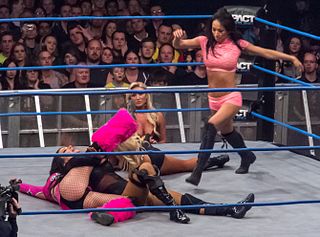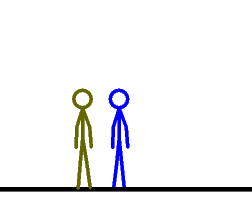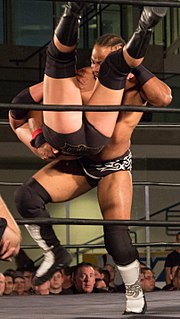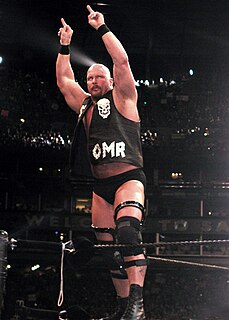Professional wrestling throws are the application of professional wrestling techniques that involve lifting the opponent up and throwing or slamming them down. They are sometimes also called "power" maneuvers, as they are meant to emphasize a wrestler's strength. Many of these moves are used as finishers by many wrestlers. Many maneuvers are known by several different names. Professional wrestlers frequently give their "finisher" new names that reflect their gimmick. Moves are listed under general categories whenever possible.
Professional wrestling holds include a number of set moves and pins used by performers to immobilize their opponents or lead to a submission. This article covers the various pins, stretches and transition holds used in the ring. Some wrestlers use these holds as their finishing maneuvers, often nicknaming them to reflect their character or persona. Moves are listed under general categories whenever possible.
A suplex is an offensive move used in amateur and professional wrestling. It is a throw that involves lifting the opponents and bridging or rolling to slam them on their backs.
Aerial techniques, also known as "high-flying moves" are maneuvers in professional wrestling using the ring's posts and ropes as aids, in many cases to demonstrate the speed and agility of smaller, nimble and acrobatically inclined wrestlers preferring this style instead of throwing or locking the opponent. Due to injuries caused by these high risk moves, some promotions have banned the use of some of them. The next list of maneuvers was made under general categories whenever possible.
Strikes are offensive moves in professional wrestling, that can sometimes be used to set up an opponent for a hold or for a throw. There are a wide variety of strikes in pro wrestling, and many are known by several different names. Professional wrestlers frequently give their finishers new names. Occasionally, these names become popular and are used regardless of the wrestler performing the technique.

In wrestling a pin is achieved by holding an opponent's shoulders to the mat for a three count. Pinfall is the term used in professional wrestling which is a way to win the match for that person or team.
In professional wrestling double-team maneuvers are executed by multiple wrestlers instead of one and typically are used by tag teams in tag team matches. Many of these maneuvers are combination of two throws, or submission holds. Most moves are known by the names that professional wrestlers give their "finishing move" names. Occasionally, these names become popular and are used regardless of the wrestler performing the technique. Moves are listed under general categories whenever possible.

A dropkick is an attacking maneuver in professional wrestling. It is defined as an attack where the wrestler jumps up and kicks the opponent with the soles of both feet; this sees the wrestler twist as they jump so that when the feet connect with the opponent one foot is raised higher than the other and the wrestler falls back to the mat on their side, or front. This is commonly employed by light and nimble wrestlers who can take advantage of their agility, and is often executed on a charging opponent, while charging at an opponent, or a combination of the two.

A powerbomb is a professional wrestling throw in which an opponent is lifted and then slammed back-first down to the mat. The standard powerbomb sees an opponent first placed in a standing headscissors position. The opponent is then lifted on the wrestler's shoulders and slammed down back-first to the mat. A prawn hold is commonly used for a pinning powerbomb.

In professional wrestling a DDT is any move in which the wrestler has the opponent in a front facelock/inverted headlock and falls down or backwards to drive the opponent's head into the mat. The classic DDT is performed by putting the opponent in a front facelock and falling backwards so that the opponent is forced to dive forward onto their head. Although widely credited as an invention of Jake Roberts, who gave the DDT its famous name, the earliest known practitioner of the move was Mexican wrestler Black Gordman, who frequently performed it during the 1970s.

Backbreaker refers to a kind of professional wrestling move which sees a wrestler dropping an opponent so that the opponent's back impacts or is bent backwards against a part of the wrestler's body, usually the knee. The standard version of the move sees the wrestler scoop their opponent horizontally before dropping to one knee, slamming the opponent's back on their other knee.
In professional wrestling, a neckbreaker is any throw or slam that focuses its attack on the opponent's neck. One type of neckbreaker involves the wrestler slamming an opponent's neck against a part of the wrestler's body, usually the knee, head or shoulder. The other type of neckbreaker is a slam technique in which the wrestler throws an opponent to the ground by twisting the opponent's neck. This also refers to a "back head slam" where a wrestler drops to the mat while holding an opponent by their neck.
A chokeslam is a type of body slam in professional wrestling, in which a wrestler grasps an opponent's neck, lifts them up, and slams them to the mat. It is common in televised wrestling because it is simple and relatively safe, yet looks powerful on camera. The chokeslam is typically used as a finisher by large wrestlers, further enhancing its perception as a powerful maneuver. This maneuver can be more damaging if the victim is slammed into an object, such as a table, steel chair, or garbage can. It is a common move performed by taller and bigger wrestlers.

A moonsault, moonsault press, or back flip splash is a professional wrestling aerial technique. It was innovated by Mando Guerrero. Much of its popularity in both Japanese and American wrestling is attributed to The Great Muta, despite it being used in North America by "Leaping" Lanny Poffo years before Muta came from Japan. In a standard moonsault, which is generally attempted from the top rope, a wrestler faces away from the supine opponent and executes a backflip landing on the opponent in a splash/press position but facing towards the elevated position. Though this move is generally attempted from the top rope to an opponent lying face up in the mat, myriad variations exist, including moonsaults that see the wrestler land on a standing opponent and forcing them down to the mat. The move is considered a higher-impact version of a splash, since the wrestler utilizes rotational speed.
A facebuster, also known as a faceplant, is generally a takedown move in professional wrestling in which an attacking wrestler forces their opponent down to the mat face-first without involving a headlock or facelock. A standard facebuster, also known as a jumping facebuster, involves the wrestler grabbing hold of the opponent's head/hair and dropping down to their knees, forcing the opponent's face into the mat.
A powerslam is a professional wrestling body slam move in which the wrestler performing the slam falls face-down on top of the opponent. The use of the term "powerslam" usually refers to the front powerslam or the scoop powerslam.

In professional wrestling, a cutter is a 3⁄4 facelockbulldog maneuver. This move sees an attacking wrestler first apply a 3⁄4 facelock before falling backwards to force the opponent face-first to the mat below.

A stunner is a common term in professional wrestling referring to the ¾ facelock jawbreaker maneuver. It was innovated by Mikey Whipwreck. The move was named for Stone Cold Steve Austin's Stone Cold Stunner finisher, a finisher suggested to him by Michael P.S. Hayes. It involves an attacking wrestler applying a three-quarter facelock before falling to a seated position and forcing the opponent's jaw to drop down on the shoulder of the attacking wrestler. The free hand is sometimes used to hold the top of the head.

The 1998 SummerSlam was the 11th annual SummerSlam professional wrestling pay-per-view (PPV) event produced by the World Wrestling Federation. It took place on August 30, 1998, at Madison Square Garden in New York City, New York. Eleven matches were contested at the event, including three on the Sunday Night Heat pre-show.

Unforgiven: In Your House was the 21st In Your House and inaugural Unforgiven professional wrestling pay-per-view (PPV) event produced by the World Wrestling Federation. It took place on April 26, 1998, at the Greensboro Coliseum Complex in Greensboro, North Carolina. This was the first WWF pay-per-view that used the new "scratch" logo for promotional work, which had first appeared on the ring apron at WrestleMania XIV. This event saw the first Inferno match and WWF's first evening gown match.











